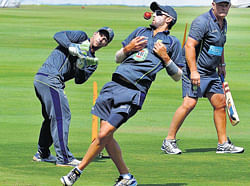
The celebrations were muted and the reactions were measured following India’s eight-wicket drubbing of Australia in the opening Test in Chennai a couple of days ago, and understandably so.
The atmosphere, however, was quite contrasting when India found themselves in a similar situation after scoring an identical win in the series opener against England in
Ahmedabad some three months ago. A 4-0 whitewash appeared realistic and England’s epitaphs were written even before the second Test in Mumbai could kick off. What followed over the next few weeks was nothing less than astonishing. The Englishmen gave India a dose of their own medicine – spin – to conquer a land where they hadn’t tasted success in 28 years.
In a strange coincidence, Australia find themselves in a position that England were in after the defeat in Ahmedabad. England were admonished for not picking left-arm spinner Monty Panesar who blazed his own trail in the rest of the series.
Australians, too, were criticised for not playing an extra spinner – particularly left-arm spinner Xavier Doherty – on a pitch where the three Indian spinners shared all the Aussie 20 wickets to fall.
It’s highly unlikely Australia would dare to field their four-pronged pace attack in
Hyderabad where the surface isn’t going to be as scruffy and powdery as the one in Chepauk but far from the one in WACA at the same time. While the visitors had announced their playing 11 almost four days before the start of the first Test, there is a lot more deliberation while choosing the side for the second Test. Needless to say, Australia are in a state of uncertainty on the issue of playing two spinners.
Australia’s quandary with regard to spinners is understandable. The recent history, since that epochal 2000-01 series to now, suggests that spinners have done nothing more than a token job for the Baggy Greens including the great Shane Warne who has 24 scalps from six Tests on Indian soil, at an average hovering around 39 and a strike rate of 73. In fact, when they won 2-1 in 2004-05, it was the likes of Jason Gillespie (20 wickets), Glenn McGrath (14) and Michael Kasprowicz (9) who had done the job for them.
Even on their other visits to India, it was the quicker lot that had grabbed bulk of the Indian wickets. In 2000-01 three-Test series, McGrath, Gillespie, Kasprowicz and Damien Fleming collected 36 wickets between them while Warne, Collin Miller and Mark Waugh accounted for mere 19. In 2008-09 (four Tests), spinners claimed (including Jason Krejza’s 12 wickets in the Nagpur Test) 20 wickets as against medium pacers’ tally of 37. Similarly, in 2010 (two Tests), 23 Indian batsmen got out to fast bowlers while only seven went to regular spinners.
Given the past record, it wasn’t surprising to see Clarke back his team’s strength (pace bowling) which wasn’t strong enough to blunt the Indian batsmen though.
“That’s something our selectors are weighing in at this moment,” said Shane Watson when asked if Australia would select two spinners for the match. “Indians’ game-plan was without doubt significantly different to ours in Chennai. Their quick bowlers bowled only 4-5 overs which was a big contrast to how the make-up of our team was. Selectors are working on it at this moment and I think that option is certainly going to be there to have a team that we feel that can have success,” he pointed out.
With due respect to their talent James Pattinson and Mitchell Starc are no match to McGrath and Gillespie while Peter Siddle is a different proposition altogether on Indian pitches. That said, the pace trio was far more effective and economical in Chennai than the lone spinner in the side Nathan Lyon who was hammered around for 215 runs in the first innings in exchange of three wickets. The off-spinner was erratic and failed to make most of the ideal conditions for a spinner. While Australia will be hugely tempted to play Doherty, who played the last of his two Tests in December 2010, they also realise that it would be catastrophic if both spinners fail to deliver.